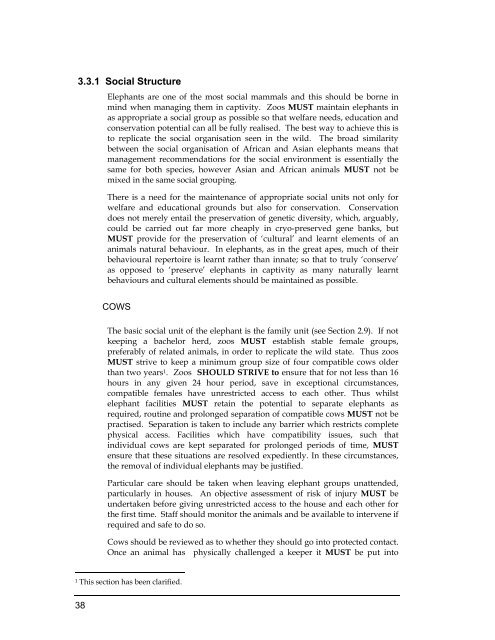Elephants Elephants - Wildpro - Twycross Zoo
Elephants Elephants - Wildpro - Twycross Zoo
Elephants Elephants - Wildpro - Twycross Zoo
Create successful ePaper yourself
Turn your PDF publications into a flip-book with our unique Google optimized e-Paper software.
3.3.1 Social Structure<br />
38<br />
<strong>Elephants</strong> are one of the most social mammals and this should be borne in<br />
mind when managing them in captivity. <strong>Zoo</strong>s MUST maintain elephants in<br />
as appropriate a social group as possible so that welfare needs, education and<br />
conservation potential can all be fully realised. The best way to achieve this is<br />
to replicate the social organisation seen in the wild. The broad similarity<br />
between the social organisation of African and Asian elephants means that<br />
management recommendations for the social environment is essentially the<br />
same for both species, however Asian and African animals MUST not be<br />
mixed in the same social grouping.<br />
There is a need for the maintenance of appropriate social units not only for<br />
welfare and educational grounds but also for conservation. Conservation<br />
does not merely entail the preservation of genetic diversity, which, arguably,<br />
could be carried out far more cheaply in cryo-preserved gene banks, but<br />
MUST provide for the preservation of ‘cultural’ and learnt elements of an<br />
animals natural behaviour. In elephants, as in the great apes, much of their<br />
behavioural repertoire is learnt rather than innate; so that to truly ‘conserve’<br />
as opposed to ‘preserve’ elephants in captivity as many naturally learnt<br />
behaviours and cultural elements should be maintained as possible.<br />
COWS<br />
The basic social unit of the elephant is the family unit (see Section 2.9). If not<br />
keeping a bachelor herd, zoos MUST establish stable female groups,<br />
preferably of related animals, in order to replicate the wild state. Thus zoos<br />
MUST strive to keep a minimum group size of four compatible cows older<br />
than two years 1. <strong>Zoo</strong>s SHOULD STRIVE to ensure that for not less than 16<br />
hours in any given 24 hour period, save in exceptional circumstances,<br />
compatible females have unrestricted access to each other. Thus whilst<br />
elephant facilities MUST retain the potential to separate elephants as<br />
required, routine and prolonged separation of compatible cows MUST not be<br />
practised. Separation is taken to include any barrier which restricts complete<br />
physical access. Facilities which have compatibility issues, such that<br />
individual cows are kept separated for prolonged periods of time, MUST<br />
ensure that these situations are resolved expediently. In these circumstances,<br />
the removal of individual elephants may be justified.<br />
Particular care should be taken when leaving elephant groups unattended,<br />
particularly in houses. An objective assessment of risk of injury MUST be<br />
undertaken before giving unrestricted access to the house and each other for<br />
the first time. Staff should monitor the animals and be available to intervene if<br />
required and safe to do so.<br />
Cows should be reviewed as to whether they should go into protected contact.<br />
Once an animal has physically challenged a keeper it MUST be put into<br />
1 This section has been clarified.

















